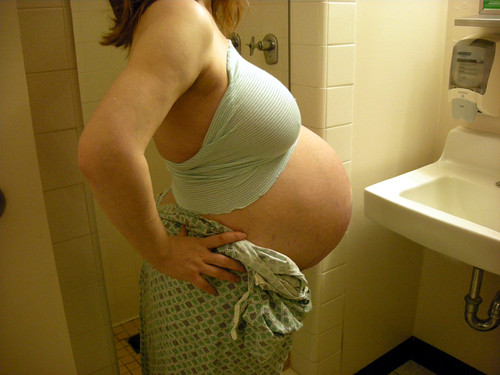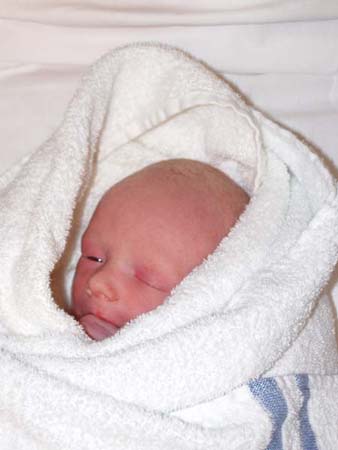36 weeks pregnant
After fertilization the embryogenesis starts. In humans, when embryogenesis finishes, by the end of the 10th week of gestational age, the precursors of all the major organs of the body have been created. Therefore, the following period, the fetal period, is described both topically on one hand, i.e. by organ, and strictly chronologically on the other, by a list of major occurrences by weeks of gestational age.
When semen is deposited in the vagina, the spermatozoa travel through the cervix and body of the uterus and into the Fallopian tubes. Fertilization of the ovum (egg cell) usually takes place in the Fallopian tube. Many sperm must cooperate to penetrate the thick protective shell-like barrier that surrounds the ovum. The first sperm that penetrates fully into the egg donates its genetic material (DNA). The egg then polarizes, repelling any additional sperm. The resulting combination is called a zygote, a new and genetically unique human organism. The term "conception" refers variably to either fertilization or to formation of the conceptus after uterine implantation, and this terminology is controversial.
The embryo spends the next few days traveling down the Fallopian tube. It starts out as a single cell zygote and then divides several times to form a ball of cells called a morula. Further cellular division is accompanied by the formation of a small cavity between the cells. This stage is called a blastocyst. Up to this point there is no growth in the overall size of the embryo, as it is confined within a glycoprotein shell, known as the zona pellucida. Instead, each division produces successively smaller cells.
Generally, if a structure pre-dates another structure in evolutionary terms, then it often appears earlier than the other in an embryo; this general observation is sometimes summarized by the phrase "ontogeny recapitulates phylogeny." For example, the backbone is a common structure among all vertebrates such as fish, reptiles and mammals, and the backbone also appears as one of the earliest structures laid out in all vertebrate embryos. The cerebrum in humans, which is the most sophisticated part of the brain, develops last. The concept of recapitulation is not absolute, but it is recognized as being partly applicable to development of the human embryo.

36 Weeks Pregnant

Picture of 36 weeks pregnant

From 36 weeks one of your

Pregnancy Week 36

36 weeks pregnant with twins,

pregnant womans 36 weeks

36 weeks pregnant with Nate

-36-weeks-pregnant

36 Weeks Pregnant

36 Weeks Pregnant

You are 36 weeks pregnant

Me at 36 Weeks Pregnant

Another week gone

36 weeks pregnant with twins

36 weeks pregnant

36 weeks pregnant to the day
When semen is deposited in the vagina, the spermatozoa travel through the cervix and body of the uterus and into the Fallopian tubes. Fertilization of the ovum (egg cell) usually takes place in the Fallopian tube. Many sperm must cooperate to penetrate the thick protective shell-like barrier that surrounds the ovum. The first sperm that penetrates fully into the egg donates its genetic material (DNA). The egg then polarizes, repelling any additional sperm. The resulting combination is called a zygote, a new and genetically unique human organism. The term "conception" refers variably to either fertilization or to formation of the conceptus after uterine implantation, and this terminology is controversial.
The embryo spends the next few days traveling down the Fallopian tube. It starts out as a single cell zygote and then divides several times to form a ball of cells called a morula. Further cellular division is accompanied by the formation of a small cavity between the cells. This stage is called a blastocyst. Up to this point there is no growth in the overall size of the embryo, as it is confined within a glycoprotein shell, known as the zona pellucida. Instead, each division produces successively smaller cells.
Generally, if a structure pre-dates another structure in evolutionary terms, then it often appears earlier than the other in an embryo; this general observation is sometimes summarized by the phrase "ontogeny recapitulates phylogeny." For example, the backbone is a common structure among all vertebrates such as fish, reptiles and mammals, and the backbone also appears as one of the earliest structures laid out in all vertebrate embryos. The cerebrum in humans, which is the most sophisticated part of the brain, develops last. The concept of recapitulation is not absolute, but it is recognized as being partly applicable to development of the human embryo.

36 Weeks Pregnant

Picture of 36 weeks pregnant

From 36 weeks one of your

Pregnancy Week 36

36 weeks pregnant with twins,

pregnant womans 36 weeks

36 weeks pregnant with Nate

-36-weeks-pregnant

36 Weeks Pregnant

36 Weeks Pregnant

You are 36 weeks pregnant

Me at 36 Weeks Pregnant

Another week gone

36 weeks pregnant with twins

36 weeks pregnant

36 weeks pregnant to the day

0 Comments:
Post a Comment
Subscribe to Post Comments [Atom]
<< Home